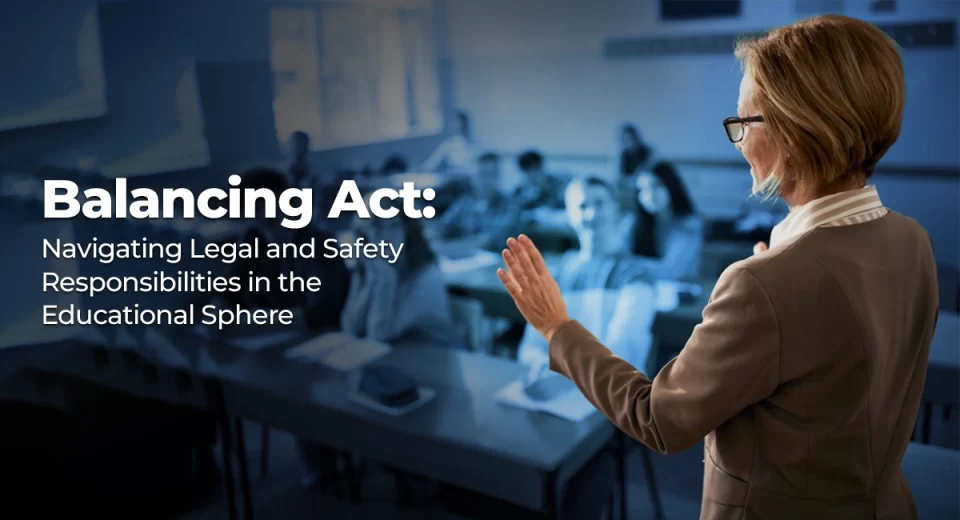Teaching is a rewarding profession, filled with the joy of imparting knowledge and nurturing young minds. But alongside lesson plans and creative activities, educators shoulder a critical responsibility: ensuring the legal and physical safety of their students. This blog dives deep into Chapter 5 of your educator’s handbook, unpacking the essential legal and safety responsibilities that keep your classroom a haven for learning.
Why Legal and Safety Responsibilities Matter?
Understanding legal and safety responsibilities is more than just checking a box. Here’s why it’s crucial for every educator:
- Protecting Students: It’s your top priority. Legal guidelines and safety measures create a secure environment where students can thrive without fear of harm.
- Building Trust: Parents entrust their children to your care. Upholding legal and safety standards demonstrates your commitment to their well-being, fostering trust and collaboration.
- Avoiding Pitfalls: Legal issues can be complex and costly. Awareness of your legal obligations helps you steer clear of potential problems.
The Legal Landscape: Keeping Your Classroom Compliant
Education operates within a legal framework that varies depending on your location. This chapter might explore some key legal areas that impact educators, such as:
Students have fundamental rights, including freedom of speech and privacy, which must be respected to maintain a positive learning environment. Understanding these rights is essential for educators to ensure they are creating a safe and respectful space for their students.
Discrimination and harassment laws are in place to protect students from unfair treatment based on race, gender, disability, or other protected characteristics. Educators should be familiar with these laws and strive to create a welcoming and inclusive classroom environment where all students feel valued and respected.
Mandatory reporting laws require educators to report suspected child abuse or neglect. Being aware of the signs of abuse and understanding the reporting process is critical for protecting vulnerable students and fulfilling legal obligations. Educators play a vital role in safeguarding their students’ well-being and must be prepared to take action when necessary.
Beyond the Law: Safety First in Your Classroom
Legal requirements provide a foundation, but safety goes beyond just checking boxes. Here’s what this chapter might delve into:
- Classroom Safety Procedures: From fire drills to emergency lockdown protocols, having clear procedures in place ensures everyone knows what to do in an emergency.
- Student Supervision: Constant and vigilant supervision is essential, especially during recess, field trips, or other activities outside the classroom.
- Identifying and Addressing Hazards: From loose floor tiles to outdated equipment, be proactive in identifying potential hazards and taking steps to mitigate them.
- Creating a Positive Learning Environment: Bullying and harassment can negatively impact student well-being. This section might explore strategies for fostering a culture of respect and kindness in your classroom.
Real-World Scenarios: Putting Your Knowledge into Practice
Theory provides a foundation, but practical application elevates understanding. This chapter offers scenarios educators may face: encountering a student with a severe allergy, handling a fight during recess to ensure safety, and addressing cyberbullying by classmates. These examples highlight the importance of applying theoretical knowledge in real-life situations to effectively manage challenges in an educational setting.
By analyzing these scenarios, you can develop your problem-solving skills and learn how to navigate unexpected situations with confidence.
Resources for Staying Ahead of the Curve
The education landscape continuously evolves, and so too do legal and safety requirements. Here, the chapter might equip you with resources to stay informed:
- Professional Associations: Many teachers’ associations offer guidance and resources on legal and safety issues.
- School Administration: Your school administration is a valuable resource for understanding specific policies and procedures relevant to your institution.
- Government Websites: Government agencies often provide information on relevant education laws and safety regulations.
Building a Culture of Safety: Beyond Individual Actions

Safety isn’t just about individual teachers; it’s about creating a culture of safety within the entire school community. Here’s how you can contribute:
- Open Communication: Encourage open communication with students, parents, and colleagues. This allows for early identification of potential problems and fosters a sense of shared responsibility for safety.
- Building Relationships: Building positive relationships with students goes a long way in creating a safe and supportive environment where students feel comfortable speaking up about concerns.
- Ongoing Training and Collaboration: Schools should provide ongoing training on legal and safety protocols for educators and staff. Collaboration among teachers, administrators, and parents can strengthen overall safety practices.
The Takeaway: Empowering Educators to Create a Safe Learning Haven
Understanding your legal and safety responsibilities empowers you to navigate your classroom with confidence. By being proactive and informed, you become a champion for student safety and contribute to a learning environment where students can flourish. Remember, knowledge is power. By familiarizing yourself with legal and safety guidelines, you’


